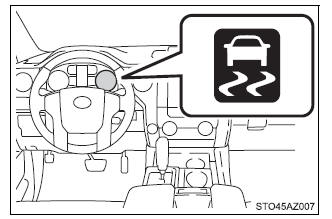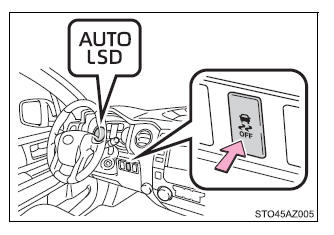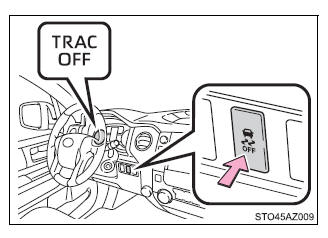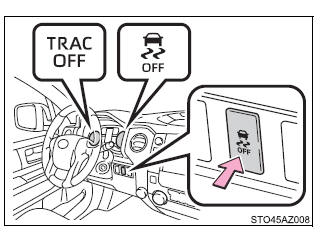To keep driving safety and performance, the following systems
operate automatically in response to various driving situations.
Be aware, however, that these systems are supplementary and
should not be relied upon too heavily when operating the
vehicle.
ABS (Anti-lock Brake System)
Helps to prevent wheel lock when the brakes are applied suddenly,
or if the brakes are applied while driving on a slippery road
surface
Brake assist
Generates an increased level of braking force after the brake
pedal
is depressed when the system detects a panic stop situation
VSC (Vehicle Stability Control)
Helps the driver to control skidding when swerving suddenly or
turning on slippery road surfaces
Trailer Sway Control
Helps the driver to control trailer sway by selectively applying
brake
pressure for individual wheels and reducing driving torque when
trailer sway is detected
TRAC (Traction Control) for 2WD models and 2WD mode on
4WD models
Helps to maintain drive power and prevent the drive wheels from
spinning when starting the vehicle or accelerating on slippery roads
Hill-start assist control
Helps to reduce the backward movement of the vehicle when
starting
on an uphill
When the TRAC/VSC/Trailer Sway Control systems are operating
The slip indicator light will flash
while the TRAC/VSC/Trailer Sway
Control systems are operating.

Disabling the TRAC systems
If the vehicle gets stuck in mud, dirt or snow, the TRAC system may
reduce power from the engine to the wheels. Pressing  to turn
the system off may make it easier for you to rock the vehicle in order
to free it.
to turn
the system off may make it easier for you to rock the vehicle in order
to free it.

■ Turning off TRAC system
2WD models and 2WD mode on 4WD models
To turn the TRAC system off,
press  . .
The "AUTO LSD" indicator light
will come on.
Press  again to turn the
system back on. again to turn the
system back on.
4H mode on 4WD models
To turn the TRAC system off,
press  . .
The "TRAC OFF" indicator light
will come on.
Press  again to turn the
system back on. again to turn the
system back on.

4L mode on 4WD models
To turn the TRAC system off,
press and hold  for more
than 3 seconds while the vehicle
is stopped. for more
than 3 seconds while the vehicle
is stopped.
The VSC off and "TRAC OFF"
indicator light will come on.
Press  again to turn the
system back on. again to turn the
system back on.

■Turning off TRAC, VSC and Trailer Sway Control systems
2WD models and 2WD mode on 4WD models
To turn the TRAC, VSC and Trailer Sway Control systems off, stop
the vehicle
completely, and then press and hold  for more than 3 seconds
while the AUTO LSD system is activated.
for more than 3 seconds
while the AUTO LSD system is activated.
4H mode on 4WD models
To turn the TRAC, VSC and Trailer Sway Control systems off, press
and
hold  for more than 3
seconds while the vehicle is stopped. for more than 3
seconds while the vehicle is stopped.
The VSC off and "TRAC OFF" indicator light will come on.
Press  again to turn the
system back on. again to turn the
system back on.
■When the VSC or TRAC system is turned off by pressing the VSC off
switch
On vehicles with pre-collision system, pre-collision brake assist and
pre-collision
braking will also be disabled. The PCS warning light will come on and
the message will be shown on the multi-information display.
■When the "TRAC OFF" indicator light comes on even if VSC off switch
has not been pressed.
TRAC cannot be operated. Contact your Toyota dealer.
■Operating conditions of hill-start assist control
When the following four conditions are met, the hill-start assist control
will
operate:
- The shift lever is in a position other than P or N (when
starting off forward/
backward on an upward incline)
- The vehicle is stopped
- The accelerator pedal is not depressed
- The parking brake is not engaged
■Automatic system cancelation of hill-start assist control
The hill-start assist control will turn off in any of the
following situations:
The shift lever is shifted to P or N
- The accelerator pedal is depressed
- The parking brake is engaged
- 2 seconds at maximum elapsed after the brake pedal is
released
■Sounds and vibrations caused by the ABS, brake assist, VSC,
TRAC,
Trailer Sway Control and hill-start assist control systems
- A sound may be heard from the engine compartment when the
brake pedal
is depressed repeatedly, when the engine is started or just
after the vehicle
begins to move. This sound does not indicate that a malfunction
has
occurred in any of these systems.
- Any of the following conditions may occur when the above
systems are
operating. None of these indicates that a malfunction has
occurred.
- Vibrations may be felt through the vehicle body and
steering.
- A motor sound may be heard also after the vehicle comes
to a stop.
- The brake pedal may pulsate slightly after the ABS is
activated.
- The brake pedal may move down slightly after the ABS is
activated.
■Automatic reactivation of TRAC, Trailer Sway Control and VSC
systems
After turning the TRAC, Trailer Sway Control and VSC systems
off, the systems
will be automatically re-enabled in the following situations:
- When the engine switch is turned off
- If only the TRAC system is turned off, the TRAC will turn on
when vehicle
speed increases
If both the TRAC and VSC systems are turned off, automatic
re-enabling will
not occur when vehicle speed increases.
■If the brake system overheats
TRAC will cease operation, and the slip indicator will change
from flashing to
being on continuously to alert the driver. Stop the vehicle in a
safe place.
(There is no problem with continuing normal driving.)
■Shifting to "4L"
VSC and Trailer Sway Control are automatically turned off.
| WARNING ■The ABS does not operate
effectively when
- The limits of tire gripping performance have been
exceeded (such as
excessively worn tires on a snow covered road).
- The vehicle hydroplanes while driving at high speed
on wet or slick roads.
■Stopping distance when the ABS is operating may
exceed that of normal
conditions
The ABS is not designed to shorten the vehicle's stopping
distance. Always
maintain a safe distance from the vehicle in front of you,
especially in the
following situations:
- When driving on dirt, gravel or snow-covered roads
- When driving with tire chains
- When driving over bumps in the road
- When driving over roads with potholes or uneven
surfaces
■TRAC/VSC may not operate effectively when
Directional control and power may not be achievable while
driving on slippery
road surfaces, even if the TRAC/VSC system is operating.
Drive the vehicle carefully in conditions where stability
and power may be
lost.
■Hill-start assist control does not operate
effectively when
- Do not overly rely on hill-start assist control.
Hill-start assist control may
not operate effectively on steep inclines and roads
covered with ice.
- Unlike the parking brake, hill-start assist control
is not intended to hold the
vehicle stationary for an extended period of time. Do
not attempt to use
hill-start assist control to hold the vehicle on an
incline, as doing so may
lead to an accident.
|
| WARNING ■When the TRAC/VSC/Trailer Sway
Control are activated
The slip indicator light flashes. Always drive carefully.
Reckless driving may
cause an accident. Exercise particular care when the
indicator light flashes.
■When the TRAC/VSC/Trailer Sway Control systems are turned
off
Be especially careful and drive at a speed appropriate to
the road conditions.
As these are the systems to help ensure vehicle stability
and driving
force, do not turn the TRAC/VSC/Trailer Sway Control systems
off unless
necessary.
Trailer Sway Control is part of the VSC system and will not
operate if VSC is
turned off or experiences a malfunction.
■Replacing tires
Make sure that all tires are of the specified size, brand,
tread pattern and
total load capacity. In addition, make sure that the tires
are inflated to the
recommended tire inflation pressure level.
The ABS, TRAC, VSC and Trailer Sway Control systems will not
function
correctly if different tires are installed on the vehicle.
Contact your Toyota dealer for further information when
replacing tires or
wheels.
■Handling of tires and the suspension
Using tires with any kind of problem or modifying the
suspension will affect
the driving assist systems, and may cause a system to
malfunction.
■Trailer Sway Control precaution
The Trailer Sway Control system is not able to reduce
trailer sway in all situations.
Depending on many factors such as the conditions of the
vehicle,
trailer, road surface, and driving environment, the Trailer
Sway Control system
may not be effective. Refer to your trailer owner's manual
for information
on how to tow your trailer properly.
■If trailer sway occurs
Observe the following precautions.
Failure to do so may cause death or serious injury.
If you make no extreme correction with the steering or
brakes, your vehicle
and trailer should stabilize. |
|